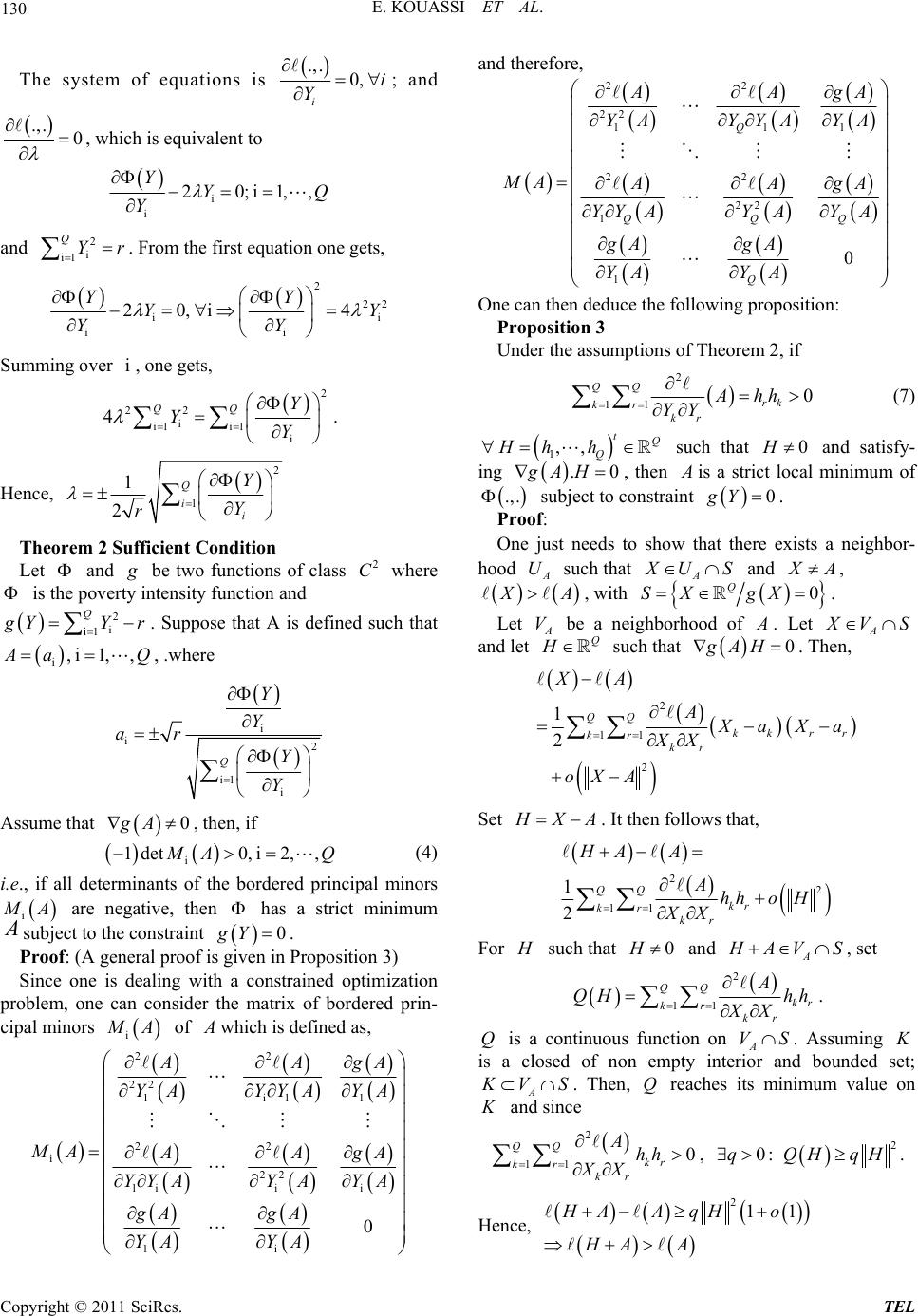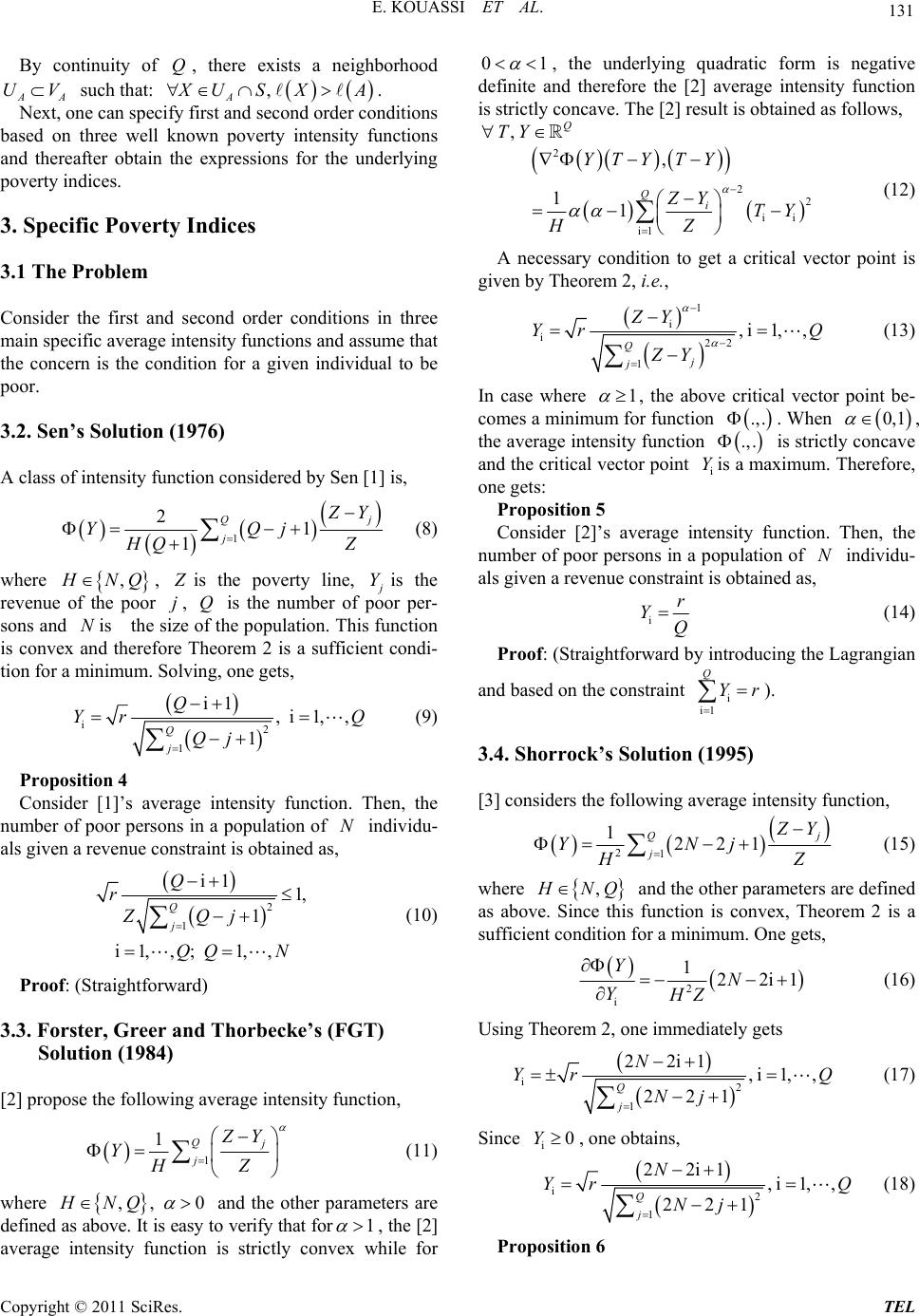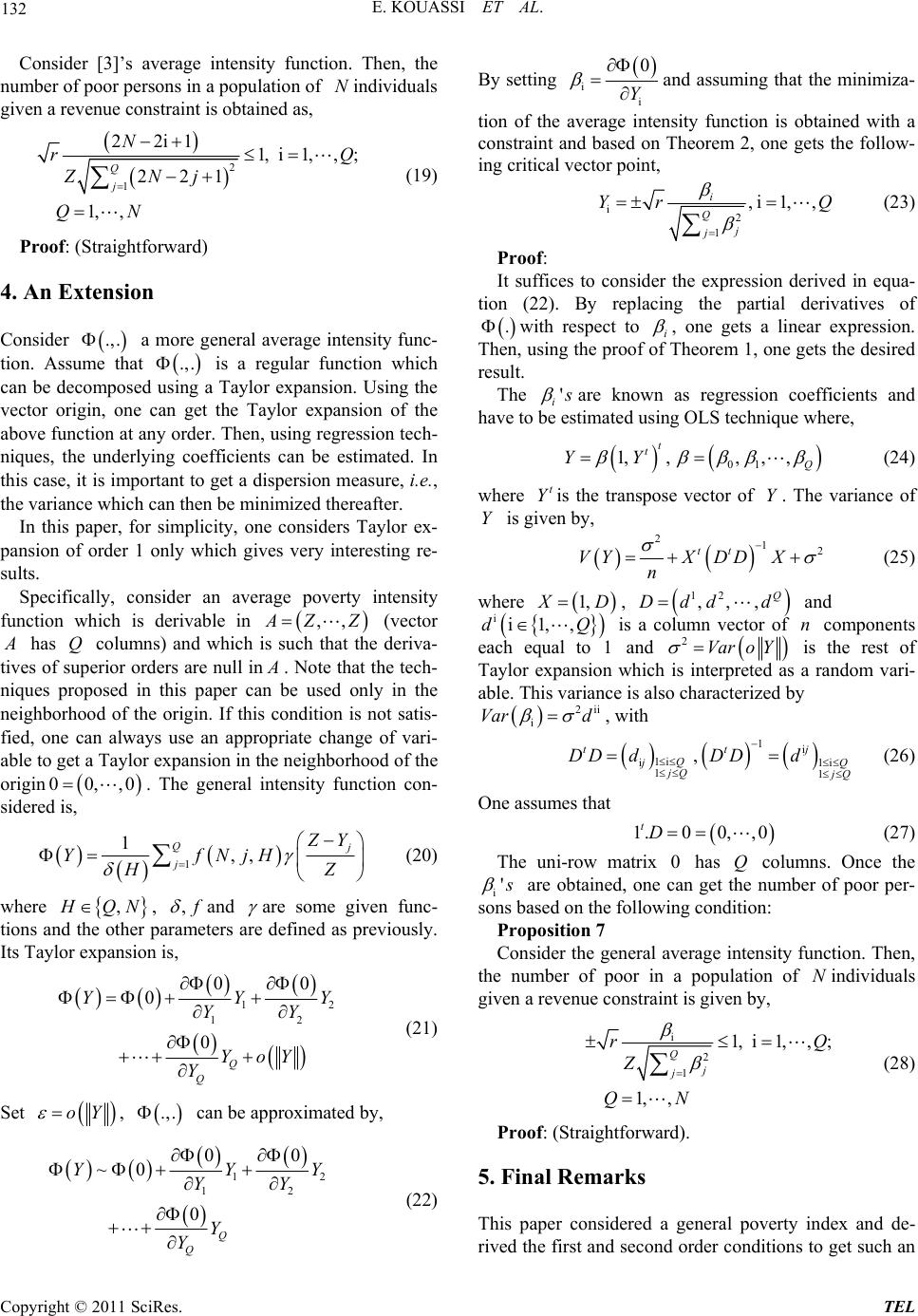 Theoretical Economics Letters, 2011, 1, 129-133 doi:10.4236/tel.2011.13027 Published Online November 2011 (http://www.SciRP.org/journal/tel) Copyright © 2011 SciRes. TEL Poverty Indices Revisited Eugene Kouassi1, Pierre Mendy2, Diaraf Seck2, Kern O. Kymn3 1Resource Economics, West Virginia University, Morgantown, USA 2Faculty of Economics, University o f Cheick Anta Diop (UCAD), Dakar, Senegal 3Division of Finance a nd Eco nomi c s, West Virginia University, Morgantown, USA E-mail: kern.kymn@mail.wvu.edu Received September 13, 2011; revised October 19, 2011; accepted Octob er 28, 2011 Abstract In this paper, a new optimization-based approach to constructing a poverty index is considered. From a gen- eral perspective, first and second order conditions based on a general poverty intensity function are derived. Then using specific intensity functions defined by [1,3] respectively, we specify related necessary and suffi- cient conditions and the underlying poverty indices. An extension based on a large class of intensity function is also investigated. Keywords: A General Poverty Index, Necessary and Sufficient Conditions, Other Poverty Indices, Poverty Intensity Functions 1. Introduction How poverty is measured is a central topic in economic and policy analyses. This paper contributes to the litera- ture on this topic by providing methods for measuring poverty in a static environment. In particular, one can define a general poverty index and show that the existing ones are some special cases of a more general index. An extension is also proposed. The remainder of the paper is organized as follows: a general approach to constructing a poverty index is con- sidered in Section 2. In particular; necessary as well as sufficient conditions to determine the number of poor persons are derived. In Section 3 based on specific inten- sity functions, conditions to determine the number of poor persons are specified. In Section 4, an extension based on a more general poverty intensity function is proposed. Finally, some concluding remarks are presented in Sec- tion 5. 2. A General Approach to Construct A Poverty Index 2.1. The Problem In general poverty issue can be seen as an optimization problem of the so called average intensity poverty func- tion defined as . Specifically, the prob- lem is to minimize a constrained program, .: Q 2 1 Min s.t Q i i Y Yr (1) where r is a given strictly positive value which represents the level richness of the individuals and i is the income of individual . The above minimiza- tion program is also equivalent to, Q Y i * Min , s.t ,Q Y Y (2) where represe n ts th e L ag r an g ian an d the Lagrange multipliers. Equation (2) can be solved to determine the number of poor persons, . Q 2.2. Solution To solve the above minimization program, first and sec- ond order conditions are required. Theorem 1 Necessary Cond ition A necessary condition to get a critical point to problem (1) or (2) is that, 2 1 ,1,, i i Q ii Y Y Yr i Y Y Q (3) Proof:  E. KOUASSI ET AL. 130 The system of equations is .,. 0, i i Y ; and .,. 0 , which is equivalent to i i 20;i1,, YYQ Y and . From the first equation one gets, 2 i i1 QY r 2 22 i ii 20,i 4 YY Y YY i Y Summing over , one gets, i 2 22 i i1i1 i 4QQ Y YY . Hence, 2 1 1 2 Q ii Y Y r Theorem 2 Sufficient Condition Let and be two functions of class where is the poverty intensity function and 2 C 2 i i1 Q YY i,i 1,, r. Suppose that A is defined such that aQ, .where i i2 i1 i Q Y Y ar Y Y Assume that , then, if 0gA i 1det0,i2, , AQ (4) i.e., if all determinants of the bordered principal minors i A are negative, then has a strict minimum subject to the constraint A gY 0. Proof: (A general proof is given in Proposition 3) Since one is dealing with a constrained optimization problem, one can consider the matrix of bordered prin- cipal minors i A of which is defined as, 22 22 i1 1 1 22 i 22 1i ii 1i 0 AgA YY AY A YA MA AgA YYA YAYA gA gA YA YA and therefore, 22 22 111 22 22 1 1 0 Q QQ Q Q AgA YYAYA YA MA AgA YY AY A YA gA gA YAY A One can then deduce the following proposition: Proposition 3 Under the assumptions of Theorem 2, if 2 11 0 QQ rk krkr Ahh YY (7) 1,, tQ Q Hh h such that and satisfy- ing 0H .0gAH , then is a strict local minimum of .,. subject to constraint . gY 0 Proof: One just needs to show that there exists a neighbor- hood such that A UA US and A, A, with 0X Q SX g . Let be a neighborhood of A V . Let A VS and let Q such that . Then, 0gAH 2 11 2 1 2 QQ kk rr kr kr XA A aXa XX oXA Set XA . It then follows that, 22 11 1 2 QQ kr kr kr HA A Ahho H XX For such that 0H and A AV S , set 2 11 QQ kr kr kr A QH hh XX . Q is a continuous function on A. Assuming is a closed of non empty interior and bounded set; A VSK VS. Then, reaches its minimum value on and since Q K 2 11 0 QQ kr kr kr Ahh XX , 2 0:qQHqH . 211HAA qHo HA A Hence, Copyright © 2011 SciRes. TEL  E. KOUASSI ET AL. 131 By continuity of , there exists a neighborhood such that: Q AA UV , A USX A . ecify first and second order coNext, one can spnditions ba and therthe expressions for the unrlying po .1 The Problem onsider the first and second order conditions in three intensity functions and assume that e concern is the condition for a given individual to be class of intensity function considered by Sen [1] is, sed on three well known poverty intensity functions eafter obtain de verty indices. 3. Specific Poverty Indices 3 C main specific average th poor. 3.2. Sen’s Solution (1976) A 1 1 21 Q j Y YQj (8) where HQ Z , NQ, is the poverty line, Y poor This fun is the revenu is the number of sons and e population. ction ex and therefore t o g e of the poor Nis th j, e size of th Q per- is convTheorem 2 is a sufficiencondi- tion for a minimum. Slvin, one gets, i2 1 i1 ,i 1,, 1 Q j Q Yr Q Qj (9) Proposition 4 Consider [1]’s average intensity function. Th number of poor persons in a population of individu- al e constraint is obtained as, en, the N s given a revenu 2 1 i1 1, 1 Q j Q rZQj i1 ,,; 1,,QQ N (10) Proof: (Straightforwa r d) 3.3. Forster, Greer and Thorbecke’s (FGT) , Solution (1984) [2] propose the fo llowing average intensity fu nction 1j HZ 1Qj ZY Y (11) where and the other parameters are defi to verify th ,, 0HNQ ned as above. It is easy at for1 , the [2] average intensity function is strictly convex while for 10 quadratic form is negative definite and therefore the [2] average intensity function is strictly concave. The [2] result is obtained as fo llows, Q , the underlying ,TY 2 2 , Q YTY TY (12) 2 ii i1 11i ZY TY HZ ecessary condition to get a critical v heorem 2, i.e., A n given by Tector point is 1 j Y re i i22 1 ,i 1,, Q j ZY Yr Q Z (13) In case whe1 um f o r , the above critical vect ni m func t io n . When or point be- co mes a mi .,. 0,1 , ncave the aver als age intnsity function is strictly co te poor persons in a population of individu- e constraint is obtained as, e .,. and the critical vector point i Yis a ma xi mu m. T he refo re , one gets: Proposition 5 Consider [2]’s average innsity function. Then, the number ofN given a revenu ir YQ (14) Proof: (Straightforward by introdu cing the Lagr angian the constraint (1995) ers the following average intensity function, and based on [3] consid i i1 QYr ). 3.4. Shorrock’s Solution 21 1221 Q j Y YNj (15) where , NQ . Sincand the other parameters are defined e this function is convex, Theo condition for a minimum. One gets, as above sufficient rem 2 is a 2 i 122i1 YN YHZ (16) Using Theorem 2, one immediately gets i2 1221 Q jNj 22i1 ,i 1,, N Yr Q (17) , one obtains, Since i Y0 i2 22i1 ,i 1,, 21 N Yr Q j (18) Proposition 6 12 Q jN Copyright © 2011 SciRes. TEL  E. KOUASSI ET AL. 132 Consider [3]’s average intensity function. Th number of poor persons in a population of nd given a revenue constraint is obtained as, en, the ividuals Ni 2 1 1, i1,, ; 221 1, , Q j rQ ZN j QN (19) 2N2i1 Proof: (Straightforwa r d) 4. An Extension Cneral average intensity func- tio is a regular function which Taylor expansion. Using the et the Taylor expansion of the tion atg co onsider .,. a more ge . Assume that .,. n can be decomposed usi ector origin, one can g ng a v above func any order. Then, using regression tech- niques, the underlyinefficients can be estimated. In this case, it is important to get a dispersion measure, i.e., the variance which can then be minimized thereafter. In this paper, for simplicity, one considers Taylor ex- pansion of order 1 only which gives very interesting re- sults. Specifically, consider an average poverty intensity function which is derivable in ,, ZZ (vector has Q columns) and which is such that the deriva- tives of superior orders are null in . Note that the tech- niques proposed in this paper can be used only in the neighborhood of the origin. If thisot satis- fd, one can always use an appropriate change of vari- able to get a Taylor expansion in thghborhood of the origin 00,,0. The general intensity function con- sidered is, condition is n e nei ie 1 1,, Q j Y YfNjH HZ (20) where , QN , , and are some given func- tions anedefined as previously. Its Taylor expansion is, d the other parametrs are 00 0 Q Q Y YoY Y Set 12 12 0 YY YY (21) oY , .,. can be app roxima ted by, 12 12 00 ~0 0Y ii 0 Y Q Q YYY YY Y (22) By setting and assuming that the minimiza- tion of the average intensity function is o constraint and based on Theorem 2, one gets the follow- ing critical vector point, btained with a i2 1 ,i 1,, i Q j j Q (23) Proof: It suffices to consider the expression derived in equa- tion (22). By replacing Yr the partial derivatives of .with respect to i , one gets a linear using the proof heorem 1, one gets the desired re expression. Then, of T sult. The ' i are known as regression coefficients and have to be estimated using OLS technique where, 01 1,,,, tQ YY, t (24) where t Y ven is the transpose vector of . The variance of Y Y is giby, 212tt VYXDDX n (25) where 1, D, 12 ,,, Q Ddd d and ii1,dQ is a column vector of n components ch equal to ,1 ea and 2VaroY is the rest of which able. This variance is also characterized by Taylor expansion is interpreted as a random vari- 2ii d i Var 1 1i 1ii11 ,t QQj , with jit jQ Q dDD d (26) One assumes that 00, ,0 t DD 1.D (27) The uni-row matrixlumns. Once the 0 has Q co i' sons bare obtained, one n getnumber of p ased on the follow condn: Consider the general average intens tha at gi ca ing the itio oor per- Proposition 7 ity function. Then, e number of poor in populion of Nindividuals ven a revenue constraint is given by, i1, i1r 2,,; QQ 5. Final Remarks This paper considered a general poverty index and de- rived the first and second order conditions to get such an 1 1, , j j Z QN (28) Proof: (Straightforwa r d). Copyright © 2011 SciRes. TEL  E. KOUASSI ET AL. Copyright © 2011 SciRes. TEL 133 in] indices based on specific innsity functions are then obtained as special cases of ty index. An extension based o rge class of intensity function is also investigated. 12718 dex. The well known [1,3 te this more general povern a la 6. References [1] A. K. Sen, “Poverty: An Ordinal Approach to Measure- ment,” Econometrica, Vol. 44, No. 2, 1976, pp. 219-231. doi:10.2307/19 ] J. Foster, J. Greer and E. Thorbecke, “A Class of De-[2 composable Poverty Measures,” Econometrica, Vol. 52, No. 3, 1994, pp. 761-765. doi:10.2307/1913475 [3] A. F. Shorrocks, “Revisiting the Sen Poverty Index,” Econometrica, Vol. 63, No. 5, 1995, pp. 1225-1230. doi:10.2307/2171728
|